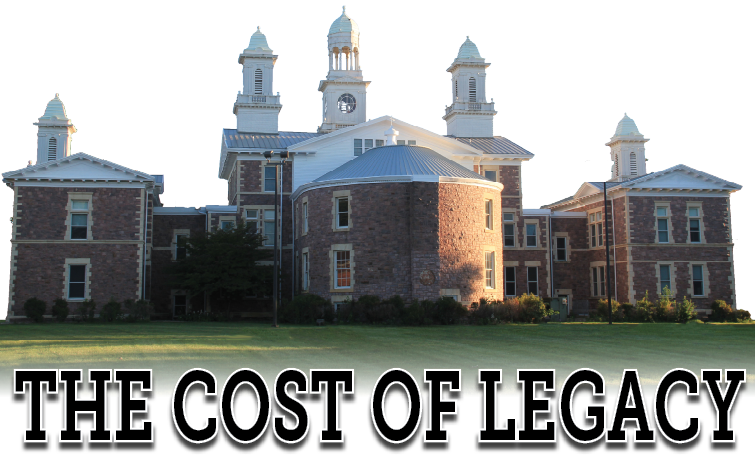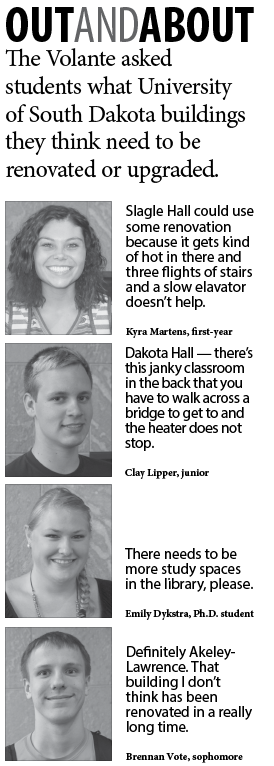
Limited funds for maintenance/repair projects to campus buildings poses dilemma
With 274 acres of space and 153 years of history, USD’s campus is home to a collection of buildings varying in size, age, appearance and purpose. Most of these buildings are worthy of pride. A few, however, are a source of concern.
A number of buildings on campus are the subject of increasing uneasiness regarding physical condition, space use, handicap accessibility and suitability to their assigned purpose.
The university finds itself in a “very similar situation to a lot of colleges that have been around for 150 years,” said Tena Haraldson, vice president of marketing, enrollment and university relations, regarding the state of USD buildings.
A part of USD’s campus for more than six decades, Julian and Noteboom Halls are two buildings that are likely entering their final years of existence, according to USD’s 10-year maintenance plan.
Both Julian and Noteboom are set to face the wrecking ball in 2019. Each project will cost roughly $750,000 to demolish.
Serving originally as residence halls, they’ve since been retrofitted into academic space.
Interactive Graphic: See where the money is going
Story continues below the graphic
Built in 1950, Julian Hall is home to several programs including nursing, social work and addiction studies. Haraldson said it’s been dubbed a problem building because of its deteriorating physical condition and the presence of asbestos.
Noteboom Hall was built four years after Julian and houses the communication science and disorders department.
It was paid a visit this past summer by the CDC after a worker claimed mold in the building sickened her. The CDC found the building to be presently safe for occupation.
With a combined estimated cost of $1.5 million, the demolitions will consume one-fourth of the 2019 maintenance budget, according to the 10-year plan.
Though problem-riddled Julian and Noteboom will likely receive minimal maintenance until their demolition, other buildings are set to undergo renovations in coming years.
Roberta Ambur, vice president of information technology, said one of USD’s buildings has the dubious distinction of being ranked the most seriously inadequate building in the entire state system, according to a list compiled by South Dakota Board of Regents.
A facilities management storage building, it’s situated with several others in a similar state of disrepair near North Complex.
Upgrades to those buildings are a significant part of USD’s ten-year maintenance and repair list, amounting to $109.5 million worth of projects planned across campus, according to the document.
However, the university’s budget for such maintenance only amounts to about $6 million per year, Haraldson said, leaving a deficit of nearly $50 million over the course of the next decade.
This will force some of the planned projects to be postponed or altered, Haraldson said.
“We’re not going to get everything brand new, so we have to prioritize,” she said. “We ask our staff to make do.”
Many of the older buildings that aren’t in as poor condition as Julian or Noteboom are displaying their age through worn roofs, windows and ventilation systems.
These buildings often present another issue – space usage.
A space-use analysis conducted two years ago by JBA Inc., a consulting firm, found a lack of certain types of space on campus and an excess of others.
There are, for example, far more large classrooms than necessary the analysis found – reflecting a time when big lecture classes were more common than today where smaller class sizes are preferable.
This distribution of space has left the campus with about 33 percent of its total classroom space sitting vacant, Haraldson said.
The role of philanthropy
Future construction of new buildings will likely only proceed with donated funds, similar to the recent addition to the Muenster University Center.
“Virtually nothing gets built without a donation,” Haraldson said.
Funding for some projects will come courtesy of Onward Campaign donations.
“The Onward Campaign is seeking to raise funds for the renovation of the Fine Arts building, the Law School building and an expansion of the National Music Museum,” Onward President and CEO Steve Brown said.
He added they would be the only three buildings “involved in any current Onward activity.”
Though donations from other sources will likely come in eventually, both Haraldson and Ambur noted these types of projects are difficult to fund through donations.
“People are typically not willing to donate money to tear something down, nor to do routine maintenance items,” Ambur said.
Amber said to help off-set some of the costs, 20 percent of each year’s tuition dollars go toward the already-stretched maintenance budget.
“We’re a state school,” Haraldson explaining the sometimes-thin budget for infrastructure upgrades.
MAP: LOCATION OF BUILDINGS
Click on the building for estimated cost through the 2026 fiscal year.
Article by: Mason Docter
Graphics Producer: Michael Geheren
RAW DATA


